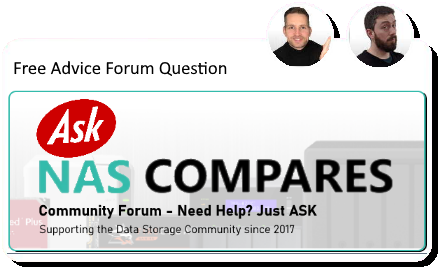07-04-2025, 01:38 PM
Thanks for getting in touch, and you’ve already done a lot of the right research here — you’re asking all the right questions. Let me break it down for you.
First off, the Ugreen DXP4800 Plus is a very solid choice at that price. It’s a good balance of features, quiet operation, and expandability — and for a home user, it’ll handle your 4K video files, photos, PC and mobile backups perfectly. Going with a 4-bay unit was also a smart move — you’ll appreciate the flexibility and resilience compared to a 2-bay.
On drives, yes — WD Red Plus 8TB is a good call. They’re among the quieter NAS HDDs (in this size range, nothing is truly silent, but these are sensible in a lounge environment).
With 4×8TB drives in RAID 5, you’re correct — you’d get about 24TB usable capacity. RAID 5 gives you a single-drive redundancy, so one drive can fail without losing your data. You could also consider RAID 6 if you wanted two-drive redundancy, but you’d lose more capacity.
On Cache
You don’t need to overthink HDD cache size in this setup — the onboard M.2 slots can be used as cache instead. NAS HDDs already have plenty of onboard cache for sequential work.
And no, you don’t have to populate both M.2 bays — you can install one NVMe SSD as a read/write cache and leave the other empty. If you want full redundancy on the cache itself, you can install two, but it’s not essential, especially for a home setup.
So in short:
• 4×8TB WD Red Plus drives (or even Seagate IronWolf if you find a better deal — also quiet and reliable)
• RAID 5 for 24TB usable
• 1 or 2 NVMe SSDs for cache (optional, but can help with lots of small file access)
The NAS will also handle your wife’s laptop backups and your mobile devices too — Ugreen’s software (or third-party apps) can back up Windows, Mac, Android, and iOS without issue.
First off, the Ugreen DXP4800 Plus is a very solid choice at that price. It’s a good balance of features, quiet operation, and expandability — and for a home user, it’ll handle your 4K video files, photos, PC and mobile backups perfectly. Going with a 4-bay unit was also a smart move — you’ll appreciate the flexibility and resilience compared to a 2-bay.
On drives, yes — WD Red Plus 8TB is a good call. They’re among the quieter NAS HDDs (in this size range, nothing is truly silent, but these are sensible in a lounge environment).
With 4×8TB drives in RAID 5, you’re correct — you’d get about 24TB usable capacity. RAID 5 gives you a single-drive redundancy, so one drive can fail without losing your data. You could also consider RAID 6 if you wanted two-drive redundancy, but you’d lose more capacity.
On Cache
You don’t need to overthink HDD cache size in this setup — the onboard M.2 slots can be used as cache instead. NAS HDDs already have plenty of onboard cache for sequential work.
And no, you don’t have to populate both M.2 bays — you can install one NVMe SSD as a read/write cache and leave the other empty. If you want full redundancy on the cache itself, you can install two, but it’s not essential, especially for a home setup.
So in short:
• 4×8TB WD Red Plus drives (or even Seagate IronWolf if you find a better deal — also quiet and reliable)
• RAID 5 for 24TB usable
• 1 or 2 NVMe SSDs for cache (optional, but can help with lots of small file access)
The NAS will also handle your wife’s laptop backups and your mobile devices too — Ugreen’s software (or third-party apps) can back up Windows, Mac, Android, and iOS without issue.





